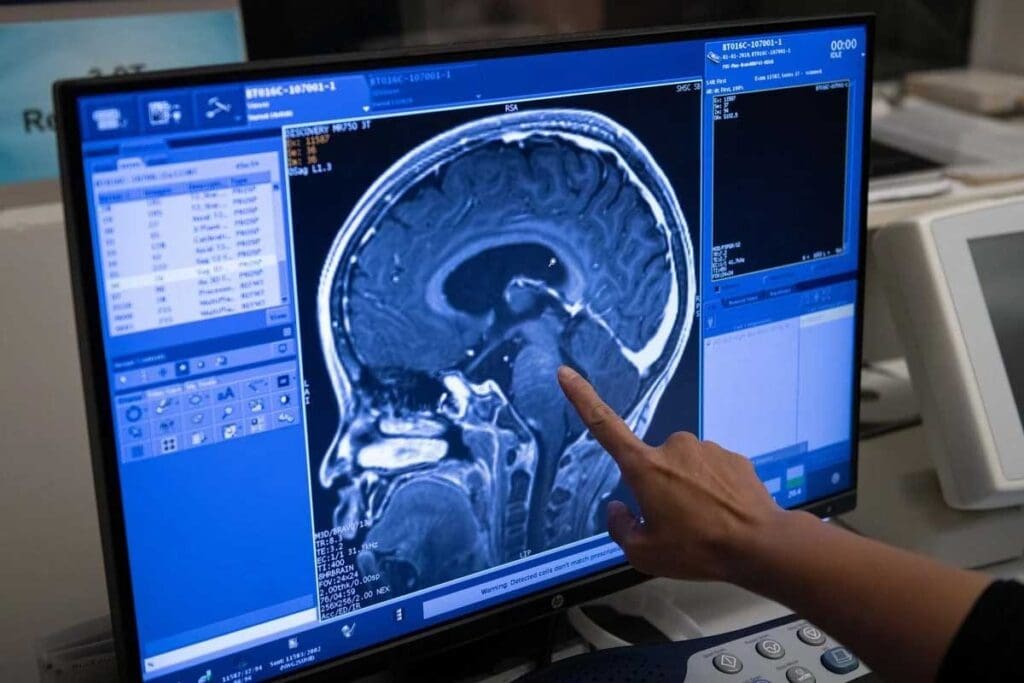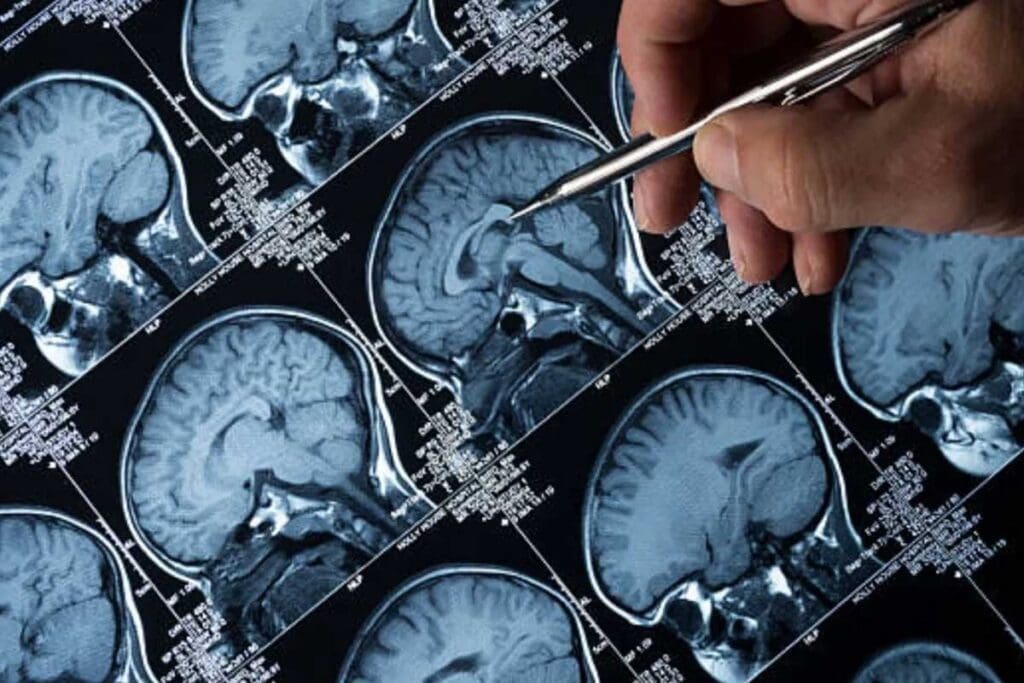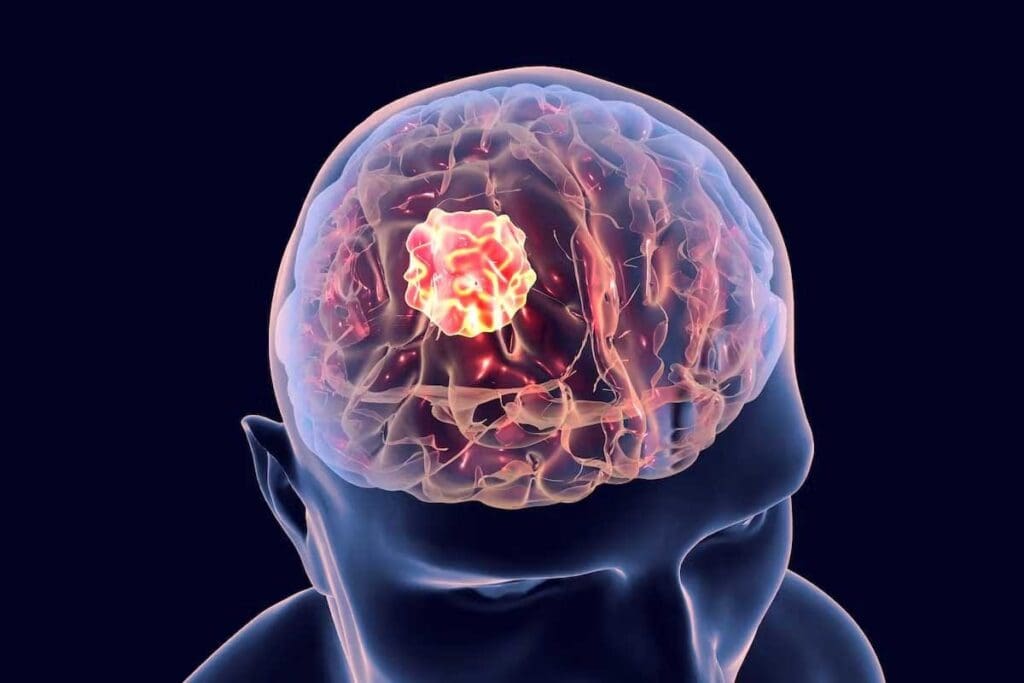Last Updated on November 20, 2025 by Ugurkan Demir

Understanding brain tumors in adults is key to good treatment plans. At Liv Hospital, we aim to give top-notch care for brain tumor patients.
Genetic mutations and inherited conditions can cause abnormal cell growth. This explains what causes a brain tumor to form, whether in the brain tissue itself or in nearby areas like nerves and glands.
The exact cause of brain tumor cancer is complex. But research has found important factors. At Liv Hospital, we help our patients understand their diagnosis and treatment choices.

Brain tumors, whether they are benign or malignant, pose big challenges in diagnosis and treatment. They are common in adults, which shows we need more research. We will look at the different types of brain tumors and their statistics to understand their impact.
Primary brain tumors start in the brain. Secondary brain tumors come from cancer spreading from other parts of the body. Most adult brain cancers start from genetic changes in brain cells or inherited syndromes. Common primary brain tumors in adults include:
Brain tumors are a big health issue, with different rates based on type and who they affect. Knowing these stats is key to health planning and research. Important facts include:
Looking into these areas helps us understand brain tumors better. This knowledge is vital for making better treatments and improving patient care.

To understand brain tumors, we must look at how cells grow. Tumors form when brain cells’ DNA changes, causing them to grow out of control. This happens due to a mix of genetic and environmental factors.
Normal cell division keeps our bodies healthy. But when cells grow abnormally, like in tumors, something goes wrong. Genetic mutations or inherited conditions can cause this.
Abnormal cell growth leads to tumor formation. It starts with a DNA mutation in a brain cell. This can be due to genetics or environmental factors. As the cell divides, it spreads its mutated DNA, causing more growth.
Tumor formation in the brain involves several steps. It begins with a genetic mutation in a brain cell. This leads to uncontrolled cell division.
The steps to tumor formation are:
Knowing these steps helps in finding treatments. Scientists are working hard to understand and fight brain tumors.
| Stage | Description |
| Genetic Mutation | A change in the DNA of a brain cell, potentially caused by genetic or environmental factors. |
| Uncontrolled Cell Division | The mutated cell divides uncontrollably, passing on its mutated DNA to daughter cells. |
| Tumor Formation | A mass of abnormal cells forms, potentially compressing or infiltrating surrounding brain tissue. |
Genetic mutations play a big role in why brain tumors happen. These changes can cause cells to grow out of control and form tumors. We’ll look into how these genetic changes lead to brain tumors.
Adults often get brain tumors because of genetic changes in brain cells. These changes can happen by mistake during DNA copying or because of environmental factors. When a brain cell’s DNA mutates, it can’t divide right, causing a tumor to grow.
Key factors contributing to spontaneous genetic changes include:
DNA damage is a key step in brain tumor development. When DNA gets damaged, cells can’t fix it or die properly. If the damage isn’t fixed, it can cause mutations that lead to tumors.
| Mechanism | Description | Impact on Tumor Development |
| DNA Replication Errors | Errors during DNA replication can lead to genetic mutations. | Increased risk of tumor formation |
| Environmental Exposures | Exposure to ionizing radiation and other environmental stressors can cause DNA damage. | Potential for genetic mutations and tumor growth |
| Impaired DNA Repair | Cells with impaired DNA repair mechanisms are more likely to accumulate genetic damage. | Increased likelihood of tumor development |
Understanding how genetic mutations cause brain tumors helps us see how complex this disease is. More research into brain tumor genetics is key to finding better treatments.
Some inherited conditions raise the chance of getting brain tumors. These genetic syndromes can make adults more likely to get brain tumors. We’ll look at the syndromes that increase this risk.
Neurofibromatosis is a genetic disorder that causes tumors on nerve tissue. There are two types: NF1 and NF2. NF1 raises the risk of gliomas. NF2 mainly affects the auditory nerves, leading to schwannomas, meningiomas, and ependymomas. People with neurofibromatosis need regular checks because of their higher risk.
Li-Fraumeni syndrome is a rare genetic disorder that raises the risk of many cancers, including brain tumors. This syndrome is caused by mutations in the TP53 tumor suppressor gene. People with Li-Fraumeni syndrome are more likely to get cancers, often at a younger age. They are at a higher risk of gliomas.
Other hereditary conditions also raise the risk of brain tumors. These include:
Knowing about these inherited syndromes is key to spotting those at higher risk. It helps in taking steps to prevent or manage brain tumors. If you have a family history of these conditions, talk to a doctor about your risk and what you can do.
Environmental risk factors play a big role in brain tumor causes. It’s important to understand how the environment affects brain tumors.
High-dose ionizing radiation is the only proven risk factor for primary brain tumors. This radiation has enough energy to remove tightly bound electrons from atoms. Ionizing radiation includes X-rays, gamma rays, and certain ultraviolet types.
Ionizing radiation is a known risk factor for brain tumors. High doses of this radiation, like from radiation therapy or nuclear fallout, increase brain tumor risk. For example, people who had radiation therapy for childhood cancers are at higher risk later in life.
The Canadian Cancer Society says ionizing radiation is a big risk factor. Studies have shown a link between this radiation and brain tumors.
While ionizing radiation is the only proven risk factor, researchers look into other possible triggers. Some of these include:
It’s important to remember that while these factors are being studied, the evidence is not yet clear. The scientific community keeps researching to understand their impact on brain tumors.
As we learn more about brain tumor causes, understanding environmental risk factors is key. By studying these factors, we can work towards better prevention and treatment.
The link between smoking and cancer, including brain tumors, has been studied a lot. While smoking is known to increase the risk of many cancers, its direct effect on brain tumors is less clear. We’ll look at the evidence to see if smoking leads to brain tumors.
There’s no solid proof that smoking directly causes brain tumors in adults. Studies show that smoking’s link to brain tumors is weaker than to other cancers.
Even though smoking is a big risk for many cancers, its role in brain tumors is being studied more. Scientists agree that smoking doesn’t directly cause brain tumors. But, it can lead to other cancers that might spread to the brain.
Smoking might not directly cause brain tumors, but it’s a big risk for cancers that can spread to the brain. These cancers, like lung, breast, and melanoma, are serious and can greatly affect patient outcomes. Knowing how smoking relates to these cancers helps us understand brain metastasis risks better.
Lung cancer, linked to smoking, can spread to the brain. So, while smoking doesn’t directly cause brain tumors, it increases the risk of cancers that can. This makes quitting smoking and preventing cancer very important.
Secondary brain tumors are a big worry for cancer patients. They happen when cancer cells move from other parts of the body to the brain. Most adult brain cancers start from cancers elsewhere in the body. This makes treatment and outlook harder for many.
Secondary brain tumors come from cancer cells spreading from other parts of the body. This often happens with lung, breast, and melanoma cancers. Knowing where these metastases come from and how they spread is key to finding better treatments.
Lung cancer, breast cancer, and melanoma are the top cancers that spread to the brain. Their cells are aggressive and can travel through the bloodstream or lymphatic system. This makes them more likely to reach the brain.
Cancer cells must go through several steps to reach the brain. First, they detach from the original tumor and invade nearby tissues. Then, they enter the bloodstream or lymphatic system, called intravasation.
Once in the blood, they must avoid the immune system and other dangers to get to the brain. When they arrive, they must leave the bloodstream and start a new tumor. This involves complex interactions with the brain’s environment.
Understanding how cancer cells move to the brain is vital for new treatments. Research into these interactions is ongoing. It holds promise for better care for patients.
Brain tumors can develop due to age-related factors. These include the buildup of risk factors over time. As we get older, the chance of genetic and environmental factors leading to tumors grows.
Some brain tumors are more common in adults. This is because of a mix of genetic and environmental factors. For example, meningiomas and glioblastomas are often found in older people. Studies show that genetic mutations build up over time, leading to more tumors in older adults.
Also, brain changes with age might help tumors grow. As we age, our cells get worse at fixing DNA damage. This can lead to tumors forming.
The risk of brain tumors isn’t just about age. It’s the buildup of risk factors over time that matters. For instance, ionizing radiation increases the risk of brain tumors. The more exposure, the higher the risk.
Other environmental and lifestyle factors also play a part. Knowing these factors helps us find ways to lower the risk of brain tumors, mainly in older adults.
To understand brain tumor causes, we need a detailed approach. This includes advanced imaging and genetic testing. Accurately diagnosing brain tumors is complex, involving several steps and technologies.
Advanced technologies are key in finding and understanding brain tumors. Magnetic Resonance Imaging (MRI) and Computed Tomography (CT) scans help see the tumor’s size and location. These tools help doctors plan the best treatment.
The biopsy is also vital. It removes tumor tissue for closer look. This can reveal the tumor’s type, grade, and genetics, guiding treatment.
Genetic testing and biomarker analysis are now critical in diagnosing brain tumors. They help find specific mutations or biomarkers in tumor cells. This info shows how aggressive the tumor is and how it might react to treatment.
Biomarkers are molecules in blood or tissues that show normal or abnormal processes. In brain tumors, they help identify the tumor’s type and genetics. Genetic tests also find inherited syndromes that may lead to brain tumors.
By using advanced imaging, genetic testing, and biomarker analysis together, we get a full picture of brain tumor causes. This way, doctors can create treatment plans that fit each patient’s tumor.
The study of brain tumors is changing fast. New findings are helping us understand what causes these tumors. Researchers are working hard to learn how brain tumors start and grow.
New ideas are coming up about how brain tumors develop. One idea is that genetic changes can start tumors. Studies show some genetic changes can make people more likely to get brain tumors.
Another idea is that things in the environment might also play a part. Some studies suggest certain environmental factors could raise the risk of getting a brain tumor. But, we need more research to know for sure.
There are many promising areas of research for brain tumors. One area is looking at the environment around tumors. This environment can help tumors grow and spread.
Also, finding new ways to diagnose and treat brain tumors is key. New imaging and biomarkers are helping doctors better diagnose and treat brain tumors.
| Theory/Area of Investigation | Description | Potential Impact |
| Genetic Mutations | Role of genetic alterations in tumor initiation and progression | Improved understanding of tumor biology and possible treatments |
| Environmental Factors | Looking into how environmental exposures might increase brain tumor risk | Could lead to ways to prevent brain tumors |
| Tumor Microenvironment | Exploring how the environment around tumors affects growth and spread | May help in finding new treatments that target this environment |
Understanding brain tumors in adults is key to better treatment. At Liv Hospital, we aim to offer top-notch care and research. This helps us improve patient lives and outcomes.
We look into genetic changes, environmental factors, and age to understand brain tumors. This knowledge helps us create specific treatments and care plans for each patient.
Our goal is to fully grasp what causes brain tumors. This requires teamwork, creativity, and a focus on excellence. At Liv Hospital, we keep up with the latest in medicine and technology. This ensures our patients get the best care. Together, we can make a big difference in fighting brain tumors and helping those affected.
Brain tumors in adults can come from genetic mutations, inherited conditions, and environmental factors. At Liv Hospital, we focus on these causes to create effective treatment plans.
The link between smoking and brain tumors is not fully understood. While smoking is linked to other cancers that can spread to the brain, research is ongoing to confirm its direct role in brain tumors.
Smoking is a risk factor for many cancers, including those that can spread to the brain. Its direct link to brain cancer is being studied, but it can contribute to other cancers that may reach the brain.
Lung, breast, and melanoma cancers often spread to the brain. Knowing how these cancers travel to and grow in the brain is key to finding effective treatments.
Brain tumors form through genetic mutations and abnormal cell growth. Understanding these processes helps in creating targeted treatments.
Genetic mutations are vital in brain tumor development. Spontaneous genetic changes and DNA damage lead to tumor formation. It’s essential to grasp these mechanisms for effective treatments.
Yes, conditions like neurofibromatosis and Li-Fraumeni syndrome raise brain tumor risk. Knowing these hereditary conditions helps in assessing risk and planning treatments.
Ionizing radiation is a known cause of brain tumors. It increases the risk of brain tumors, making it important to limit exposure to such radiation.
Some brain tumors are more common in adults due to risk factor accumulation and age-related changes. These factors contribute to their prevalence.
Advanced technologies like genetic testing and biomarker analysis are key in identifying brain tumor causes. They help guide treatment decisions.
Louis, D. N., Perry, A., Wesseling, P., Brat, D. J., Cree, I. A., Figarella-Branger, D., Hawkins, C., Ng, H. K., Pfister, S. M., Reifenberger, G., Soffietti, M., von Deimling, A., & Ellison, D. W. (2021). The 2021 WHO Classification of Tumours of the Central Nervous System: a summary. Neuro-Oncology, 23(8), 1231–1251.
https://academic.oup.com/neuro-oncology/article/23/8/1231/6325707
Subscribe to our e-newsletter to stay informed about the latest innovations in the world of health and exclusive offers!